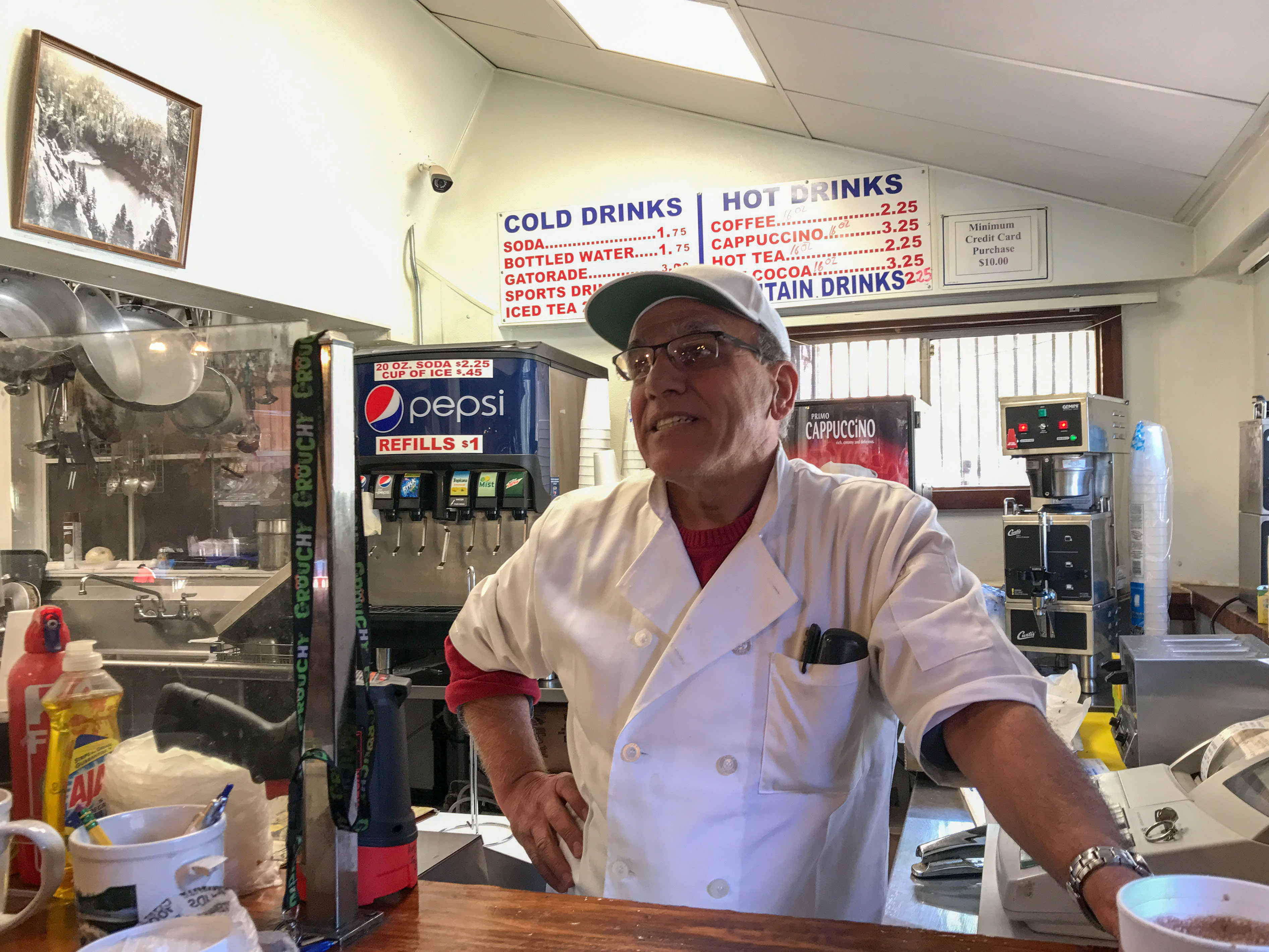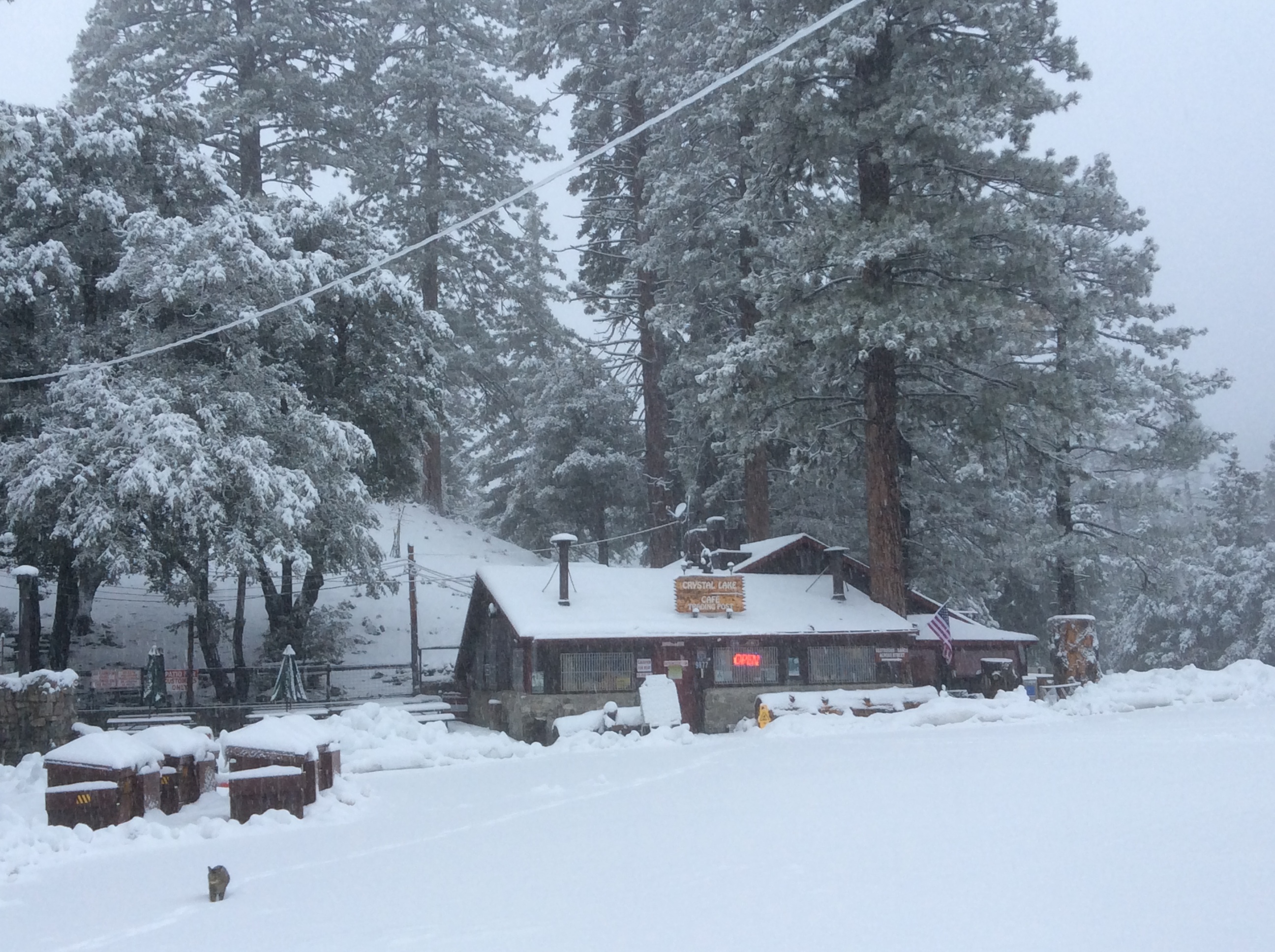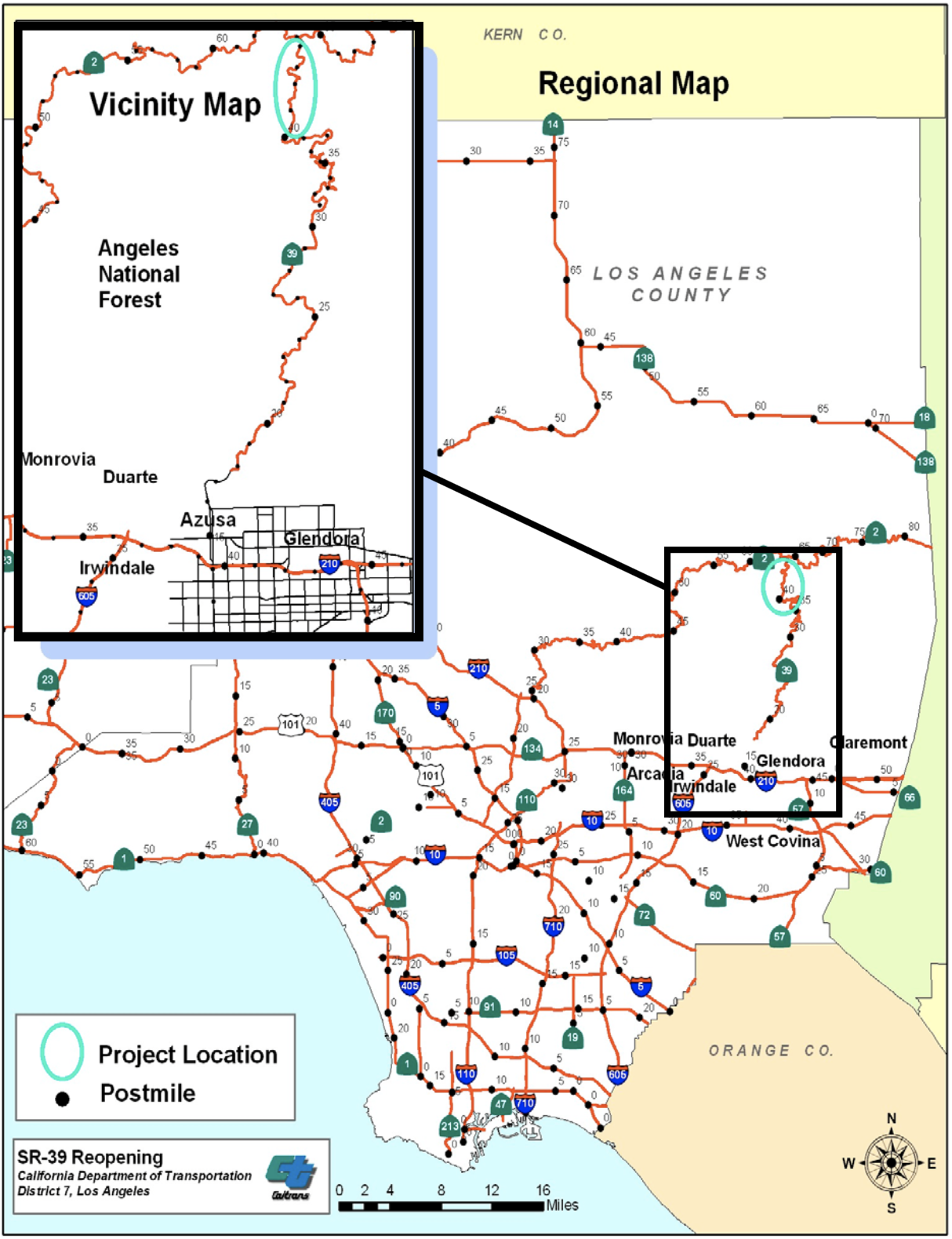A turnoff about 25 miles up Highway 39 from Azusa leads to Crystal Lake Cafe, a small restaurant serving visitors in the middle of the forest. Adam Samrah, the cafe's owner, dreams of the day when customers can easily stop by for a cup of coffee from cities as far away as La Cañada to the west or Wrightwood on the northern side of the mountains.
"You can come here, have coffee, have lunch and go back," he says. "In one hour and a half you can make a little hike and go back."
For the past 40 years, however, the northern section of Highway 39—the road that would make a sightseeing loop through the mountains possible—has been closed. Visitors can only reach the cafe and the lake it's named after from Azusa, and a locked gate blocks the last 4-mile stretch of the highway connecting it to the other main road through the San Gabriel Mountains, Highway 2. To reach that road, also known as the Angeles Crest Highway, drivers on the southern side of the San Gabriels must travel about 20 miles to the west.
"I get a lot of people disappointed, 'Oh we couldn't go down to Highway 2,'" says Samrah. "I say no and I have to explain to them why."
The California Department of Transportation operates highways 2 and 39, both state routes. The agency has completed multiple environmental assessments over the past few decades evaluating completely reopening Highway 39, yet little progress has been made. Emergency and law enforcement vehicles regularly pass through the gates, but the road remains closed to the public.
 Adam Samrah, the owner of Crystal Lake Cafe.
Adam Samrah, the owner of Crystal Lake Cafe.
Proponents of reopening the road have emphasized its importance as an escape route from the forest in a fire or other emergencies as well as its capacity to increase access to wilderness areas for residents around the mountains. They say the reopened road would also potentially bring economic benefits to newly reconnected cities.
But Caltrans says that construction and maintenance costs, the hazard of rock falls on the road and the potential risk to the protected Nelson bighorn sheep in the area have prevented them from reopening the road. The agency is currently considering a new project for the road, but the plan may still keep the route closed to the public, leaving the area with nearly 30 miles of highway that dead-ends in the middle of the mountains.
Unsuccessful attempts to reopen the road
Highway 39 was completed in the early 1960s, but the northern section connecting to Highway 2 was closed in 1978 after a rock- and mudslide damaged the road.
Caltrans began working in 1990 to allow emergency access to the Angeles Crest Highway through the closed section of the road. The agency's maintenance activities were interrupted several years later when "potential sensitive biological resources" were found in the area, according to a 2003 environmental assessment. Access to emergency services was again granted in 2003 "after studies showed that reopening it would not pose any significant environmental impact."
The Azusa Chamber of Commerce and other advocates of opening the road—and even Caltrans—cite the many potential benefits of fully reopening Highway 39.
 Crystal Lake Cafe in the snow. Photo: Adam Samrah
Crystal Lake Cafe in the snow. Photo: Adam Samrah
Some, at first glance, seem trivial. "Kids who have never seen snow, who are right here in my neighborhood, would be able to go up in an hour or so to Wrightwood and experience the snow," says Steve Castro, the chief executive officer of the Azusa Chamber of Commerce.
Samrah says that access to snow—an elusive sight in sunny Southern California—is an important draw of Highway 39. The road is also an economic equalizer. He says that many people bring their kids to Crystal Lake for an inexpensive way to experience snow.
"People come from LA County, working people," he says. "They don't have the car or time to go to Big Bear. They love to come here when there's snow." He adds that his store receives the most business when there's snow, and that sometimes California Highway Patrol even has to help manage the lines of cars jamming the highway as LA residents flock to the mountains for the unique experience.
Castro says that opening the road would also have economic value. "We're going to get people, and hopefully from all over the region, getting off the 210 and coming up Azusa Avenue, Highway 39, and coming through our town," where he says they'll hopefully spend money on gas or at restaurants or other Azusa stores.
Roy Moore, treasurer of the Wrightwood Chamber of Commerce, also wants the highway open to help his town's economy. Reopening the road "would be a big plus for the town of Wrightwood," he says. Moore adds that Wrightwood used to get many motorcyclists and drivers coming via Highway 39 into the town, but with its extended closure, "We don't have the clientele coming from the valley area down there that we did have."
Caltrans' 2009 environmental impact assessment states that reopening Highway 39 to Highway 2 would save people traveling from Azusa to Wrightwood nearly half an hour of driving time, while reducing the number of miles driven in the opposite direction on connecting highways to make the trip.
If there’s a disaster, there’s no way for the central part of the valley to get out.
-Barrett Wetherby
The report affirms the economic benefit to connected cities of opening the road. It also describes other benefits for local communities, such as increasing access to recreational opportunities in the San Gabriel Mountains' Angeles National Forest.
Even more important than recreational or economic value are the safety concerns around reopening the road.
Barrett Wetherby has been involved in the area for decades as a result of his family's owning a cabin on the West Fork of the San Gabriel River near Highway 39. He worked on getting the road open for years for recreational interests, until someone at a meeting he attended brought up the safety issues.
"If there's a disaster, there's no way for the central part of the valley to get out. I'd never even thought about that," he says. "That's been my argument with Caltrans since then."
Castro has also heard from many people with concerns about safety.
"As somebody said in one of our meetings, when somebody dies because they couldn't get out—a flood or a fire or whatever—who's going to tell that family, the gate was locked and we couldn't find the guy with the key?" he says.
Castro has been involved in efforts to get the road reopened.
"When we started this thing [over a decade] ago we worked up a signature list, walking around different areas in the city, and most people signed on: 'Yeah, we want that reopened,'" he says.
After the signatures were collected, Castro says Caltrans held a meeting in which they presented several plans to repair the road.
"We chose [plan] B," Castro recalls. "And the guy in charge from Caltrans said, 'Great, B it'll be, and that's $32 million and we've got it and we'll start tomorrow.' In 2009. It never happened."
Looking down at Highway 39 from the closure gate.
The reason was the Nelson bighorn sheep, according to a presentation by Caltrans office chief Shafiqul Islam at an April 2016 San Gabriel Mountains Community Collaborative meeting.
There has been some disagreement around the sheep's protected status.
The California Department of Fish and Wildlife identifies bighorn sheep as fully protected, but an exception allows sport hunting of mature Nelson bighorn rams. Caltrans also pointed out in its 2009 environmental assessment that the Nelson bighorn sheep population in the San Gabriel Mountains is not considered part of the endangered Peninsular Bighorn Sheep population. Furthermore, Caltrans wrote that because the San Gabriel population is self-sustaining and has been used to repopulate other areas, it meets the requirement for exemption from fully protected status.
Caltrans sent a letter to the Department of Fish and Wildlife in 2008 to confirm that the Nelson bighorn sheep were not, as a result, fully protected. According to the environmental assessment, the department agreed.
The environmental assessment for the repair project still included several sections on the bighorn sheep, stating that the project would have no effect on any species listed or proposed as endangered or threatened. Noting that bighorn sheep have been observed near the road, the report stated, "Little evidence is available to support any conclusion about the use of SR-39 as a travel route by large mammals."
However, according to Islam's presentation, the California Department of Fish and Wildlife notified Caltrans after the project's approval that "the Nelson bighorn sheep are a fully protected species, which means that not a single sheep can be harmed or killed during the construction of the project or after the opening of the road."
"All sheep are fully protected," says Chanelle Davis, an environmental scientist at the California Department of Fish and Wildlife. "They've always been [protected]."
She says that she's seen sheep use Highway 39. "That's kind of the crux. Because [the] sheep are fully protected, if someone hits a sheep on that road, there's lots of consequences."
The sheep aren't confined to the area around the road closure. A March 2018 volunteer survey observed eight bighorn sheep around South Fork Big Rock Creek, north of Highway 2.
"It's always a concern" that sheep may be hit on the roads, says Davis. But she says that the sheep have likely adapted to the presence of cars on Highway 2, whereas they've grown used to the lack of activity on Highway 39.
She adds that the closure is particularly important because it's near a lambing area, and that disrupting the sheep's habits by reopening the road could have a long-term effect.
"You take out one ram on a road or one ewe on a road, that's not going to devastate your whole population unless you're hitting sheep daily," she says. "It's more the change in behavior that will cause a snowball effect that can impact your population."
She says that a new environmental assessment is in the works to determine the sheep's use of the road.
"We understand there has to be a balance with all the different factions, but our first priority is the protection of the population," she says.
A sign on Highway 39 for Crystal Lake.
Abandoning the highway
In a letter to the acting Forest Service supervisor dated Aug. 31, 2011, Caltrans Deputy District Director Ronald Kosinski wrote that "we have determined that it is not realistic or cost effective to continue pursuing the implementation of this reopening project."
Kosinski cited the cost, saying that it had significantly increased from the 2008 estimate of $32 million due to environmental studies and necessary re-engineering related to protecting the sheep. He also stated that rock slides would likely persist and that the highway had little significance to the state. "Clearly a road that has been closed for 33 years does not and would not serve any meaningful State purpose," he wrote, adding that the highway "has served primarily local recreational uses and has minimal economic impact" with its main importance being for emergency access.
The department's 2009 environmental impact assessment predicted an average of over 2,800 vehicles using the road daily in 2030 if the road were fixed.
Kosinski continued that Caltrans planned to terminate the reopening project as well as formally relinquish control of State Route 39 within Forest Service boundaries to LA County or the City of Azusa.
However, although the route was considered "essential," the other agencies also refused to take it over for financial reasons, according to a Caltrans Transportation Concept Report from June 2015.
But Caltrans also could not abandon the highway entirely, the 2015 report said, because of expensive federal environmental restoration requirements as a result of the bighorn sheep.
Multiple Caltrans reports and regulations clearly show the agency's duty to maintain the road.
The California Streets and Highways Code stipulates that Caltrans "shall improve and maintain the state highways" and "shall monitor the cumulative impact of fragmented gaps in the state highway system to identify safety and long-term maintenance issues."
Beyond safety issues concerning the road's use as an escape route, leaving the road unmaintained presents other safety hazards. The 2009 environmental assessment says that without rehabilitation of the road, rocks and erosion will obstruct water flow, flooding the highway and increasing risk to workers performing necessary maintenance.
Caltrans is again considering a plan to repair the road, according to Senior Transportation Engineer James Vu. One of the proposed project alternatives would open the road for recreational use, but the minimum build alternative would only fix the pavement in order to maintain the road as an emergency route. Either way, project approval and environmental clearance will take several years. "Right now, I have no idea" when the project might be completed, Vu says.
The Caltrans website says that the long-shut northern section of Highway 39 will be closed through November 2020 due to construction. Karl Price, a senior environmental planner at Caltrans, says they won't meet that reopening date.
Price adds that Caltrans has not yet been in contact with the Department of Fish and Wildlife to discuss the proposed project alternatives. "That probably won't happen for at least a few months," he says. He adds that he doesn't yet know how the two departments will resolve the issue of the bighorn sheep that derailed past projects. "That's something that we're going to have to work through in the coming months and next couple of years," he says.
Caltrans currently services the closed section of the road. Maintenance manager Greg Flores works primarily on Highway 39. "As of now, I just maintain it in a way that emergency vehicles can move back and forth," he says.
"There are a lot of rock slides," he adds, and says he doesn't know an expected date for it to reopen.
"If and when they open it, it is my road," he says, explaining that he'll continue maintaining the highway either way.
"They never know this exists"
Events such as fires often close other sections of Highway 39 as well.
Soon after Samrah purchased his business, a fire caused a section of the highway south of Crystal Lake to be closed, cutting off access to his store and rental cabins for nine years. He was able to resume his business once the road reopened in 2011, but worries about the potential for future closures, which would effectively cut off his business from both sides.
He says the closures also erode the public's memory of the area while preventing people from revisiting childhood destinations and introducing the area to their own children.
"The new generation, they never know this exists. I get people from West Covina [who say], 'I never knew this was here,'" Samrah says. "Older people know, but they close [the road] so much that they come here and say, 'Oh my god, they closed it, we came here many times.'"
He recalls one woman who cried while visiting from Texas. "She said, 'Well, I tried to come from Texas many times to visit where I grew up,'" Samrah says. He explains that she lived in Azusa and grew up poor. "This was the only place they enjoyed," he adds, but she wasn't able to visit it for years. "She came many times during the nine years when the road was closed."
Samrah, who recently turned 60, says he sometimes worries about the southern section of the road being closed again, especially with the continued closure of the northern section. "If they closed the road on me it would be a disaster," he says. "Especially with my age, and I have small kids."
An immigrant from Lebanon, he believes in America's ability to overcome hurdles and its ideals of freedom—from pursuing a chosen business to having access to public lands. "You start closing here to make it easier and safe, yeah you'll be safe if you lock everybody in their houses," he says. "But America is built differently. America has freedom."
Samrah says he believes Highway 39 will eventually fully reopen. "I believe America is so strong," he says. "This is a piece of cake for them."
Except where indicated, all photos by Erika Klein.
A sign for an old road closure.

